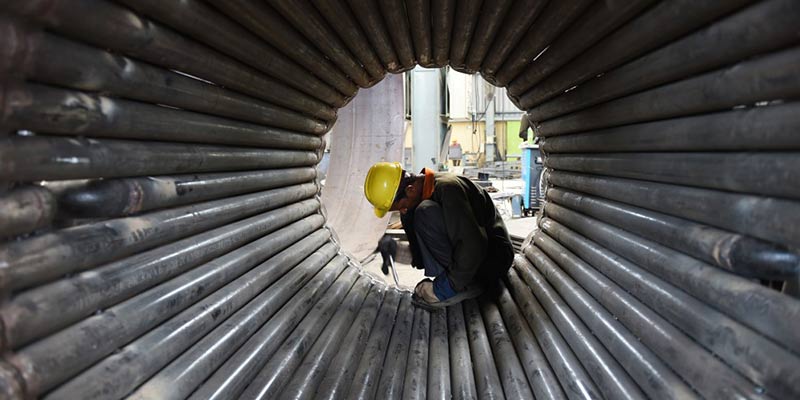- India
- Oct 01
- Kevin Savio Antony
Key infra sectors’ growth contracts 1.8% in August
The growth in production of eight key infrastructure sectors entered a negative zone after three-and-a-half years, contracting 1.8 per cent in August 2024 due to decline in output of coal, crude oil, natural gas, refinery products, cement and electricity, according to official data released.
Recent Trends in the Core Sector
• The growth of core sectors — coal, crude oil, natural gas, refinery products, fertilizer, steel, cement and electricity — was 13.4 per cent in August 2023.
• During April-August this fiscal, the output of core sectors rose 4.6 per cent against 8 per cent in the same period last fiscal.
• The eight core sectors contribute 40.27 per cent to the Index of Industrial Production (IIP) which measures overall industrial growth.
• The previous low was recorded at (-)3.3 per cent in February 2021.
• Coal, crude oil, natural gas, refinery products, cement and electricity recorded a contraction of 8.1 per cent, 3.4 per cent , 3.6 per cent, 1 per cent, 3 per cent and 5 per cent, respectively, in August.
• However, fertilizer output rose by 3.2 per cent during the month under review as against 1.8 per cent in August 2023.
• The growth rate of steel production slowed to 4.5 per cent in August 2024 against 16.4 per cent in the same month last year.
• Excess rainfall impacted mining activity, with the output of coal, crude oil, and natural gas declining, while also leading to a contraction in electricity generation in the month.
• The decline in these sectors was accentuated by an elevated base, with a deficient rainfall in August 2023 supporting the output of these sectors in that month.
What is core sector?
• The core sector in India includes eight vital industries: coal, crude oil, natural gas, refinery products, fertilizers, steel, cement, and electricity.
• These industries are considered the backbone of India’s industrial framework, and their performance is crucial for determining the overall economic health of the country.
Significance of core sector:
• Economic Indicator: The growth rate of the core sector is often a reliable indicator of the country’s economic trajectory. A strong growth rate in these industries usually reflects a positive economic outlook, while contraction signals potential slowdowns.
• Barometer for Industrial Health: The performance of core industries is seen as a reflection of industrial and economic vitality. For example, industries like steel are essential for construction and manufacturing, and electricity is fundamental for powering industrial activities. Their growth influences the broader economy by driving production, investment, and employment.
• Interconnectedness and Multiplier Effect: Core industries are closely linked to other sectors, creating a multiplier effect. Growth in one core industry can boost other industries, leading to wider economic benefits, while a decline in any of these industries can have a ripple effect, hampering the overall economy.
• Infrastructure Development: Infrastructure development is heavily dependent on core industries. The production of steel, cement, and electricity is essential for building roads, bridges, power plants, and other infrastructure projects. This further fuels economic growth by improving connectivity and supporting other industries.
What is core sector growth?
• Core sector growth refers to the growth rate of the key industries that make up the core sector of an economy, typically calculated on an annual or monthly basis.
• This growth reflects the performance of industries such as coal, electricity, crude oil, cement, natural gas, steel, refinery products, and fertilizers. These industries are crucial for overall economic development, as they influence multiple sectors across the economy.
Index of Eight Core Industries (ICI):
• The Index of Eight Core Industries (ICI) is a comprehensive metric that tracks the performance of these industries. It is published monthly by the Office of the Economic Adviser (OEA) under the Department for Promotion of Industry and Internal Trade (DPIIT), Ministry of Commerce & Industry.
• The ICI measures the production output of the eight core industries, providing insights into the overall industrial health of the economy.
Components of the ICI:
The ICI includes the following industries:
• Coal – Excluding coking coal, it measures total coal production.
• Electricity – Considers generation from thermal, nuclear, hydro, and imports from Bhutan.
• Crude Oil – Reflects total crude oil production.
• Cement – Tracks cement production, including large and mini plants.
• Natural Gas – Measures the total output of natural gas.
• Steel – Covers production of both alloy and non-alloy steel.
• Refinery Products – Includes the total refinery output.
• Fertilizers – Monitors the production of various fertilizers such as urea, ammonium sulfate, calcium ammonium nitrate, and complex grade fertilizers.
Weightage of core industries in ICI:
The eight industries are assigned different weights based on their significance in the ICI:
• Petroleum Refinery Products: 28.04 per cent
• Electricity: 19.85 per cent
• Steel: 17.92 per cent
• Coal: 10.33 per cent
• Crude Oil: 8.98 per cent
• Natural Gas: 6.88 per cent
• Cement: 5.37 per cent
• Fertilizers: 2.63 per cent.
ICI and its relevance:
Release Timing: The ICI for a given month is released with a time lag of one month on the last day of the following month, approximately 12 days before the Index of Industrial Production (IIP) is published.
Base Year: The current base year for the ICI, in line with the IIP, is 2011-12.
Policy Usage: Policymakers, including the Ministry of Finance, various ministries, banks, and the Reserve Bank of India (RBI), use the ICI to assess economic performance and to support infrastructure financing decisions.
(The author is a trainer for Civil Services aspirants.)


